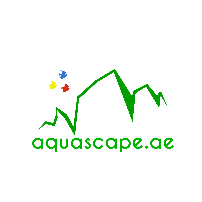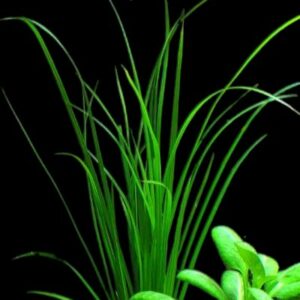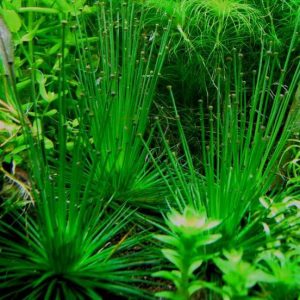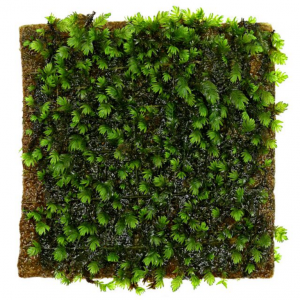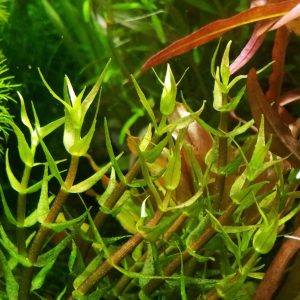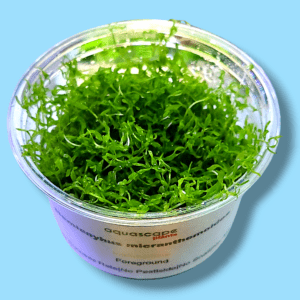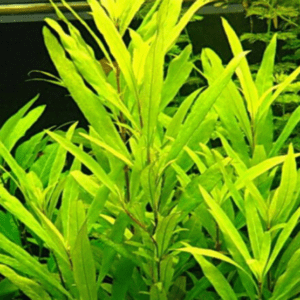Subtotal: د.إ29.75
Plants
Showing 97–120 of 187 results
-
Live Plants & Neutrients, Plants for terrarium, Plants, Potted
Cryptocoryne wendtii Green Pot
- Robust time-tested Crypt
- Forms dense groups
- Green to slightly brown hues
Cryptocoryne Wendtii Green – A Hardy Aquatic Plant for Stunning Aquascapes
Cryptocoryne Wendtii Green is a popular freshwater aquarium plant, prized for its lush green leaves and low-maintenance care. Native to Sri Lanka, this versatile plant thrives in various water conditions, making it ideal for beginners and experienced aquarists alike.
With its compact growth habit and tolerance for low light, Cryptocoryne Wendtii Green is perfect for foreground to midground placement in aquascapes. It adapts well to CO2-enriched and non-CO2 setups, providing a natural and serene aesthetic to any tank.
Enhance your aquarium’s ecosystem with this hardy, slow-growing plant that offers shelter and grazing spots for fish and invertebrates. Choose Cryptocoryne Wendtii Green for a vibrant and long-lasting underwater display.
SKU: n/a -
Live Plants & Neutrients, Plants, Potted
Cyperus Helferi
Cyperus helferi is a popular aquatic plant species that is native to Thailand in Southeast Asia. It is a relatively new plant in the aquarium hobbyist community and is known for its unique appearance and growth characteristics. This plant is typically found in ponds and slow-flowing water and is one of the few plants from the Cyperaceae family that can grow fully submersed
SKU: n/a -
Plant Fertilizers, Plants
EASYLIFE 25 ROOT STICKS
Optimal root feeding
The Easy-Life 25 Root Sticks are ideal to feed plants directly at the roots. The product contains 25 pieces of special clay sticks that are very nutritious and have a high iron content. Due to the special pre-treatment of these sticks, they do not fall apart immediately upon contact with water. The release of nutrients goes very gradually over a period of several weeks. The water will not get cloudy at all, so algae cannot take advantage of that. The product is very easy to use and causes no additional water pollution.
Use these root sticks for plants with a strong need for root nutrition such as Cryptocoryne, Echinodorus or Lotus. If the soil layer is very narrow or the plant roots are small, the sticks can be very easily broken into smaller pieces. The root sticks can therefore be used in all cases.
SKU: PS0025 -
Live Plants & Neutrients, Plants, Potted
Echinodorus ‘Aquartica’
This compact, green, low-growing Echinodorus cultivar was developed by the plant breeder Christian Iversen from Aquartica company in Denmark. Under aquarium conditions, it forms a spreading rosette of broadly elliptic, medium green leaves with wavy margin. In stark contrast to the many vigorously growing, large swordplants, it is even suited for the foreground and for nano aquariums as it gets only 10-20 cm. Furthermore it grows quite slowly and contents with only moderate light intensity.
This plant is mostly delivered in its emersed (terrestrial) stage, with more roundish, longer stalked leaves. Planted into the aquarium, it will develop its typical submerged growth habit.
Recommendable low-growing Echinodorus cultivar
10-20 cm tall
Medium-green leaves with wavy edge
Also suited for the foreground and nano aquariumsSKU: n/a -
Live Plants & Neutrients, Plants, Potted
Echinodorus argentinensis Mother Plant XXXL 80cm high
Echinodorus argentinensis is a species of aquatic plant in the Alismataceae family, native to South America (Argentina, Brazil, Paraguay, and Uruguay). It is a robust, semi-aquatic or aquatic plant often used in ponds and large aquariums due to its impressive size and attractive foliage.
Description:
-
Leaves: Broad, lanceolate to oval, with prominent veining. Mature leaves can grow up to 12-18 inches (30-45 cm) long.
-
Color: Bright to dark green, sometimes with a slightly wavy edge.
-
Growth Form: Rosette-forming, with long petioles (leaf stems) emerging from a central root crown.
-
Size: Can reach up to 20-24 inches (50-60 cm) in height when fully grown.
-
Flowers: Produces tall inflorescences with small white flowers when grown emersed (above water).
-
Root System: Strong, fibrous roots that anchor well in substrate.
Care Tips:
-
Lighting:
-
Moderate to high light is ideal for healthy growth.
-
Can tolerate lower light but may grow more slowly and produce smaller leaves.
-
-
Water Parameters:
-
Temperature: 68-82°F (20-28°C).
-
pH: 6.5-7.5 (slightly acidic to neutral preferred).
-
Hardness: Soft to moderately hard water (2-15 dGH).
-
-
Substrate:
-
Nutrient-rich substrate (such as aquarium soil or clay-based gravel) promotes vigorous growth.
-
Root tabs or liquid fertilizers help if the substrate is inert.
-
-
CO2 & Fertilization:
-
Benefits from CO2 supplementation but can grow well without it.
-
Regular fertilization (iron-rich fertilizers) prevents yellowing leaves.
-
-
Pruning & Maintenance:
-
Remove old, decaying leaves to encourage new growth.
-
Large specimens may need thinning if they overshadow other plants.
-
-
Propagation:
-
Produces adventitious plantlets on flower stalks when grown emersed.
-
Can also be divided by splitting the root crown.
-
Special Considerations:
-
Best suited for larger aquariums or ponds due to its size.
-
Can be grown emersed in paludariums or bog setups, where it may flower.
-
Relatively undemanding but appreciates stable water conditions.
Would you like recommendations for tankmates or compatible plants?
SKU: n/a -
-
Live Plants & Neutrients, Plants, Potted
Echinodorus parviflorus ‘Tropica’
Echinodorus parviflorus ‘Tropica’ from aquascapeplants is a popular aquatic plant in the aquarium hobby, known for its attractive rosette form and relatively easy care requirements. It’s a cultivar of Echinodorus parviflorus, often referred to as the “Black Sword Plant” due to its dark-green to brownish leaves.
SKU: n/a -
Sold out!Live Plants & Neutrients, Plants, Potted
Echinodorus Rose
Echinodorus ‘Red Diamond’ was bred in the Ukraine and is probably a cross between Echinodorus horemanni ‘Red’ and Echinodorus x barthii. The resultant hybrid is an attractive, relatively small plant with ruby-red sword-shaped leaves, 15-25 cm long.
Unlike many other sword plants, Echinodorus ‘Red Diamond’ remains moderate in size (20-30 cm wide rosette), so it is extremely well suited as a solitary plant, even in small aquariums. Increasing the nutrients in the substrate results in more abundant growth, while favourable light conditions promote the formation of the ruby-red leaves.
- Red leaves, dark red nerves
- Narrowly egg-shaped leaves
- Relatively low
- Also suitable for small tanks
Genus Echinodorus Difficulty medium Usage Background, Midground Growth medium pH value 5 – 7 Temperature tolerance 15 – 30°C Carbonate hardness 0 – 21°dKH General hardness 0 – 30°dGH Propagation Proliferating inflorescences, Rhizomteilung Can grow emersed? yes SKU: n/a -
Live Plants & Neutrients, Plants, Plants for terrarium, Potted
Echinodorus vesuvius
Echinodorus vesuvius, also known as the Vesuvius Sword Plant, is a unique and eye-catching aquatic plant. Here’s a detailed description:
Overview
Common Name: Vesuvius Sword Plant Scientific Name: Echinodorus vesuvius (also known as Helanthium bolivianum ‘Vesuvius’) Family: Alismataceae Origin: Hybrid, likely from Singapore
Appearance
Leaves: Narrow, twisted, and spiral-shaped, resembling corkscrew vallisneria Height: Typically grows between 10 to 30 cm (4 to 12 inches) Growth Rate: Fast, especially in nutrient-rich environments
Care Requirements
Lighting: Medium to high intensity CO2: Beneficial but not essential Water Parameters:
- pH: 5.5 to 7.5
- Hardness: Soft to moderately hard water
- Temperature: 21 to 25 °C (70 to 77 °F)
SKU: n/a -
Sold out!Plants, Potted
Eleocharis vivipara Tall hairgrass
The Tall Hairgrass forms hair-thin long leaves. On the leaf tips, adventitious plants are formed. Eleocharis vivipara is ideal for planting higher “meadows” in the back of the aquascape.
Difficulty easy Usage Background, Midground Growth medium pH value 4 – 7 Temperature tolerance 5 – 29°C Carbonate hardness 2 – 5°dKH General hardness 0 – 30°dGH Propagation Proliferating inflorescences, Splitting, cutting off daughter plants SKU: n/a -
Live Plants & Neutrients, Plants, Tissue Culture Cup
Eriocaulon quinquangulare
Eriocaulon quinquangulare is a unique and attractive aquatic plant belonging to the Eriocaulaceae family. Native to regions like India, Sri Lanka, and Southeast Asia, it thrives in wetlands, marshes, and shallow waters. This plant is known for its rosette-forming growth and striking star-shaped flowers (when grown emersed).
Description:
-
Leaves: Thin, grass-like, forming a dense rosette.
-
Stems: Short, with flower stalks emerging from the center when grown emersed.
-
Flowers: Small, white to pale yellow, with a star-like appearance (only when grown above water).
-
Size: Typically 5–15 cm tall, depending on growing conditions.
-
Growth: Slow to moderate, preferring stable water conditions.
-
Temperature: 20–28°C (68–82°F).
-
pH: 5.5–7.0 (slightly acidic to neutral).
-
Hardness: Soft to moderately hard water (GH 4–10, KH 1–6).
-
CO₂: Benefits from CO₂ injection (20–30 ppm) for optimal growth.
SKU: n/a -
-
Live Plants & Neutrients, Plants, Potted
Fissidens fontanus “Phoenix Moss” on pad
- Also labeled “Fissidens geppii”
- Highly decorative aquatic moss
- Feathery appearance
- Dark green coloration
- Also suitable for cold water tanks
Fissidens fontanus is a delicate feathery dark green aquatic moss clinging to driftwood or rocks with its rhizoids, forming roundish cushions or lawn-like populations. It is also known under the synonym Octodiceras fontanum and in the trade as “Fissidens geppii”. We cultivate two variants of this species, which differ in size when growing in the same environment. The smaller variant is what we call “Phoenix moss”. It develops around 3 to 5 mm long leaflets, is of a somewhat darker green and has an overall more delicate growth habit and looks more compact as it branches more readily than the larger variant.
Difficulty easy Usage Epiphyte (growing on hardscape), Midground, Nano tanks, Foreground, group Aquascaping fine-leaved Growth medium pH value 5 – 7 Temperature tolerance 4 – 26°C Carbonate hardness 0 – 14°dKH SKU: n/a -
Sold out!Plants, Potted
Fissidens sp. “Mini Nobilis”
This small Fissidens moss entered the trade as Fissidens nobilis or F. nobilis “Mini” but belongs with certainty not to the much larger, stronger species Fissidens nobilis from Asia. belongs to a different species. It develops about 2 mm broad shoots that are densely set with tiny leaves. With time, it forms thick, fluffy cushions of many shoots.
- Small, filigree Fissidens
- Fine, feather-like structure
- Forms thick, fluffy cushions
- Very rare in trade
SKU: n/a -
Accessories, Aquascape Essentials, Aquascape Tools, Plants
FLOURISH GLUE GEL TYPE 8G
Size: 8 gFlourish Glue is a superior cyanoacrylate gel for attaching moss and plants to rocks, driftwood, and even gravel. It’s uniquely useful when planting bunch plants. Simply apply Flourish Glue, plant as usual and the plants stay rooted in the substrate. It bonds within seconds and has excellent control, hold and durability characteristics. It can even be used underwater. Flourish Glue can be used for any aquascaping in freshwater or saltwater aquariums or for any plastics repairs.
KEY FEATURES:
- Cyanoacrylate adhesive
- Attach moss and plants to rocks, driftwood, and even gravel
- No more thread, no more weights
- Bonds within seconds
- Can be used underwater
DIRECTIONS:
Dispense a small amount of glue prior to each use. Apply a small amount of glue to moss or plant roots and press against desired surface for 20 seconds. For bunch plants, apply glue and plant as usual. Wipe tip free of glue before replacing the cap.SKU: SE3116 -
Sold out!Live Plants & Neutrients, Plants, Tissue Culture Cup
Glossostigma elatinoides
- The most popular ground covering plant there is
- Forms intense green carpets
- Fast grower
Glossostigma elatinoides is a very popular plant for Japanese-style tanks. It is one of the smallest aquarium plants, which makes it ideal for the foreground. A difficult-to-care-for plant that needs a lot of light. If the lighting is too weak, it tends to grow upwards. Must not be shaded off by larger plants. When planting, make small tufts (approx. 1/8 of the pot) and plant at a distance of only a few centimetres. Thus you will get a ground-covering group in less time. The injection of CO2 and soft water enhance growth considerably.
Genus Glossostigma Difficulty medium Usage Nano tanks, Foreground, group, Foreground, ground cover Aquascaping forms a small-leaved carpet Growth fast pH value 4 – 7 Temperature tolerance 4 – 30°C Carbonate hardness 0 – 14°dKH General hardness 0 – 30°dGH Propagation Runners, Cuttings, Splitting, cutting off daughter plants Can grow emersed? yes SKU: n/a -
Sold out!Plants, Tissue Culture Cup
Gratiola viscidula in vitro
This North-American Gratiola species is one of the most interesting new aquarium plants. It is still very rare in Europe. It is related to the European Gratiola officinalis, however, it differs very much from it.
- Forms dense carpets or cushions
- Small leaves
- Spiky texture
- Rare, new in the trade
Difficulty easy Usage Midground, Foreground, group Growth slow Propagation Cuttings, Splitting, cutting off daughter plants Can grow emersed? yes SKU: n/a -
Sold out!Live Plants & Neutrients, Plants, Potted
Hair grass pre grown carpet plant 14x10cm
Pad Size 14x10cm
Eleocharis parvula, commonly known as Dwarf Hairgrass, is a popular aquatic plant used in aquascaping to create lush, carpet-like effects in aquariums. When pre-grown on a pad, it offers several advantages for easy installation and quick establishment in your tank.– Carpet-Like Growth:The plant forms a dense, low-growing mat (2-5 cm tall) resembling a grassy meadow.
– Easy Placement: The pad can be simply placed on the substrate, eliminating the need for individual planting.
– Faster Establishment: Since the grass is already rooted in the pad, it adapts quickly to the aquarium environment.
– Reduced Melt: Pre-grown Hair grass plants often transition better underwater, minimizing die-off compared to emersed-grown plants.SKU: n/a -
Sold out!Live Plants & Neutrients, Plants, Tissue Culture Cup
Helanthium “quadricostatus” Chain sword
Helanthium “Quadricostatus” Chain Sword: The Versatile Foreground Aquatic Plant
Description: Enhance your aquarium with the lush greenery of Helanthium “Quadricostatus” Chain Sword. Known for its vibrant green foliage and ease of care, this plant is perfect for both beginners and seasoned aquarists looking to create a stunning underwater landscape.
Key Features:
-
- Compact Growth: Forms dense, bushy clusters that spread horizontally, creating a lush, green carpet that enhances the visual appeal of your aquarium.
- Hardy and Adaptable: Thrives in a range of water conditions (pH 6.5-7.5, temperature 20-28°C), making it suitable for a variety of tank setups.
- Easy Propagation: Propagates quickly through runners, allowing you to easily expand your plant coverage and maintain a thriving aquascape.
- Aesthetic Appeal: Ideal for foreground planting, providing a natural and beautiful cover that complements other plants and decorations in your tank.
- Available in the UAE: Readily accessible for aquarium enthusiasts in the United Arab Emirates, ensuring you can effortlessly add this stunning plant to your collection.
Genus Helanthium Difficulty easy Usage Midground, Nano tanks, Foreground, group, Foreground, ground cover Aquascaping forms a grass-like lawn Growth fast pH value 5 – 7 Temperature tolerance 10 – 30°C Carbonate hardness 0 – 14°dKH General hardness 0 – 30°dGH Propagation Runners Can grow emersed? yes SKU: n/a -
-
Live Plants & Neutrients, Plants, Tissue Culture Cup
Hemianthus micranthemoides pearl weed
Hemianthus micranthemoides: The Essential Aquatic Plant for Your Aquarium
Description: Enhance your aquarium with the lush green beauty of Hemianthus micranthemoides, also known as Pearl Weed. This versatile aquatic plant is loved by aquarists for its vibrant color and adaptability, making it a great choice for creating a stunning underwater landscape.
Key Features:
- Compact Growth: Forms dense, bushy clusters that spread horizontally, creating a lush green carpet that enhances the visual appeal of your aquarium.
- Hardy and Versatile: Thrives in various water conditions (pH 6.0-7.5, temperature 20-28°C), making it suitable for both beginners and experienced hobbyists.
- Easy Propagation: Propagates quickly through stem cuttings, allowing you to easily expand your plant coverage.
- Aesthetic Appeal: Provides a beautiful foreground or midground cover, complementing other plants and decorations in your aquascape.
- Available in the UAE: Easily accessible for aquarium enthusiasts in the United Arab Emirates, ensuring you can effortlessly add this stunning plant to your collection.
SKU: n/a -
Live Plants & Neutrients, Plants, Potted
Hornwort ‘Foxtail’ aquarium plant
Description
- Very fast grower.
- Undemanding.
- Recommended for initial planting and breeding tanks.
- Rootless, also growing as free-floating plant.
- Competes with algae.
- Good for breeding guppies
Genus Ceratophyllum Difficulty very easy Usage Background, Plant for spawning, Midground, Water surface Aquascaping fine-leaved Growth very fast pH value 6 – 9 Temperature tolerance 4 – 30°C Carbonate hardness 5 – 24°dKH General hardness 0 – 30°dGH Propagation Fragmentation, Cuttings Can grow emersed? no BUY MORE SAVE MORE!
Buy 5 or more for additional discount!
Buy 10 or more to get super discount!
SKU: n/a -
Live Plants & Neutrients, Plants, Plants for terrarium, Potted
Hydrocotyle leucocephala Brazilian Pennywort
-15%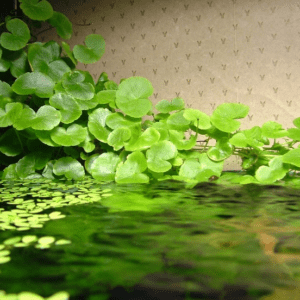 Live Plants & Neutrients, Plants, Plants for terrarium, Potted
Live Plants & Neutrients, Plants, Plants for terrarium, PottedHydrocotyle leucocephala Brazilian Pennywort
Hydrocotyle leucocephala, commonly known as Brazilian Pennywort, is a versatile and attractive aquatic plant. Here’s a detailed profile:
Hydrocotyle leucocephala Overview
Common Name: Brazilian Pennywort Scientific Name: Hydrocotyle leucocephala Family: Apiaceae Origin: Central and South America
Care Requirements
Lighting: Medium to high intensity CO2: Beneficial but not essential Water Parameters:
- pH: 5.0 to 9.0
- Hardness: Very soft to very hard water
- Temperature: 22 to 28 °C (72 to 82 °F)
SKU: n/a -
Live Plants & Neutrients, Plants, Potted
Hydrocotyle Tripartita in Pot
Size: Pot
Hydrocotyle tripartita
- Forms creeping or overhanging shoots
- Pretty leaf form
- Fresh light green colour
- Can be used in many different ways
- One of the most popular plants in aquascaping
Genus Hydrocotyle Difficulty easy Usage Midground, Nano tanks, Foreground, group, Foreground, ground cover Growth very fast pH value 5 – 7 Temperature tolerance 10 – 30°C Carbonate hardness 0 – 14°dKH General hardness 0 – 30°dGH Propagation Runners, Cuttings Can grow emersed? yes BUY MORE SAVE MORE!
Buy 5 or more for additional discount!
Buy 10 or more to get super discount!
SKU: n/a -
Green Wall, Moss Frames & Art, Plants, Plants for terrarium, Potted, Terrarium Accessories, Tissue Culture Cup
Hydroponic Slotted Mesh Net Cups, Black
-15% Green Wall, Moss Frames & Art, Plants, Plants for terrarium, Potted, Terrarium Accessories, Tissue Culture Cup
Green Wall, Moss Frames & Art, Plants, Plants for terrarium, Potted, Terrarium Accessories, Tissue Culture CupHydroponic Slotted Mesh Net Cups, Black
unit/pcs
They are made of quality plastic that offer durable use without crumbling. Wide lip on the top of containers, easy to grab, lift and transport.These plastic net cups promote a more efficient plant growth through aeration.
Slotted design let the roots grow their own way, right down through the pot and out of the sides, allow for bigger, healthier roots.
Promotes a more efficient plant growth through aeration.
Smaller diameter at the bottom for easier removal of netpot with attached roots.
There are many holes in the bottom, which produce healthy roots with even drainage.
It is suitable for seeding, cutting and seedling nursery.SKU: n/a -
Live Plants & Neutrients, Plants, Potted
Hygrophila Angustifolia
Hygrophila angustifolia (Willow Hygro or Narrowleaf Hygrophila) is a popular aquatic plant in the aquarium hobby due to its attractive appearance and relatively easy care. Here are some tips and care guidelines to help you grow and maintain this plant successfully:
1. Lighting Requirements
- Moderate to High Light: Hygrophila angustifolia thrives under moderate to high lighting conditions.
- Light Duration: Provide 8-10 hours of light per day to promote healthy growth.
- Low Light Adaptation: While it can survive in low light, growth will be slower, and the plant may become leggy or lose its vibrant color.
2. Water Parameters
- Temperature: Keep the water temperature between 22-28°C (72-82°F).
- pH Level: Prefers slightly acidic to neutral water with a pH of 6.0-7.5.
- Water Hardness: Can tolerate a wide range of water hardness but thrives in soft to moderately hard water (2-15 dGH).
3. Substrate and Fertilization
- Nutrient-Rich Substrate: Use a nutrient-rich substrate to support root growth. If using inert substrates like sand or gravel, supplement with root tabs.
- Liquid Fertilizers: Regularly dose a comprehensive liquid fertilizer to provide essential nutrients like nitrogen, phosphorus, potassium, and micronutrients (iron, magnesium, etc.).
- CO2 Supplementation: While not mandatory, CO2 injection can significantly enhance growth and overall health, especially in high-light setups.
SKU: n/a

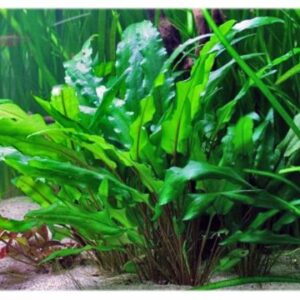 Cryptocoryne wendtii Green Pot
Cryptocoryne wendtii Green Pot 